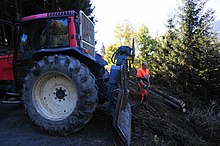Forestry winch
A forestry winch is a cable winch , which in the forest to the back and cases of trees is used.
Classification
Forestry winches are available as attachments that can be attached to the three-point linkage if required. This type of winch is divided into two different variants. On the one hand, there are mechanical products in which the coupling for pulling the rope is operated via a pulley block . This variant is more cost-effective, but the operator has to stand near the cable winch and therefore does not have the tree trunk in view when operating on unfavorable terrain, which can lead to the tractor being moved instead of moving the tree. In addition, it is possible, as improper operation, to move the tree with the clutch slipping, which leads to increased clutch wear. On the other hand, the hydraulically operated clutch is operated via an electrical switch or via radio . The advantage is that the winch can be operated with less effort and, if it is operated by radio remote control, an operating position can be selected in which both the tractor and the tree trunk can be seen. The disadvantage is that the winch has its own hydraulic system, which almost doubles the price of entry-level models.
On the other hand, there are winches that are permanently installed in forest tractors. Usually it is mounted in front of the engine and the ropes are passed under the tractor cab . The advantage here is that the cable winch can also be carried and a logging trailer, for example , can be attached. The disadvantage is that if the tractor is used for arable farming , the cable winch is very difficult to dismantle and therefore additional weight has to be transported.
Often a cable winch is also mounted on the crane boom of a logging trailer. This is used to pull logs that are too far away within the reach of the crane.
functionality
The power of the cable winch is fed to the cable winch via the power take-off shaft on the attachment winch or the cardan shaft on permanently attached winches. Then the torque is increased and the speed slowed down via a gearbox . Usually the PTO speed of 540 rpm should also be selected in order to keep the implementation effort low. This is followed by a clutch, which is operated either hydraulically or via a pulley block. On a rope drum there is usually a steel rope or, usually at an additional cost, a lighter, tear-resistant plastic rope. The rope is guided over pulleys in order to guarantee an even roll-up and to determine the pulling height of the rope. If the rope exit is lower, the risk of the tractor tipping over is lower, but the log is pulled more into the ground, which causes more damage. After pulling the tree, the rope is kept on tension by a band brake . It is released via a second or the same pulley system or, in the case of hydraulic winches, via a button.
Wooden back
The winch is used on the one hand to back wood . Here sliding eyes are mounted on the rope. These slide on one side on the rope and on the other side a forest chain can be attached. Most manufacturers have an iron bar with incisions on the left and right to attach logs with forest chains. Some winch owners have a tractor that is too small to pull the logs directly and therefore use the winch to generate the required force. In extreme cases, the slipping clutch is also used to end the back in time to prevent the tractor from tipping over.
Rope-assisted felling
Due to the somewhat greater effort, the following method is only used for problem trees which can only be wedged over with great effort or not at all. The rope is attached with the ladder or the Königsborner attachment technique at a height of about 5–6 m . Then the felling cut is carried out. The wedges are only needed to prevent the tree from falling back. When everyone is out of the danger area, the chainsaw operator gives the order to move. The winch is unable to stop a tree falling in the wrong direction.
Risk of accident
As with many machines in the forest , the risk of accidents is high. Since the tractor can be moved in the event of improper use, especially if it is not pulled straight to the direction of travel but to the side, it is only allowed to operate it from the age of 18 and attention is required. For training purposes, the age is reduced to 16 years. It is also possible to move another tree with the trunk, which also poses danger. All cable winches are operated with a dead man's switch to ensure that the cable winch is switched off quickly in the event of danger or failure of the operator. It is important to ensure that a sufficiently large tractor is used to operate the cable winch in order to avoid the tractor being moved.
Individual evidence
- ↑ Rope-assisted felling. fbz-koenigsbronn, accessed on August 12, 2017 .
